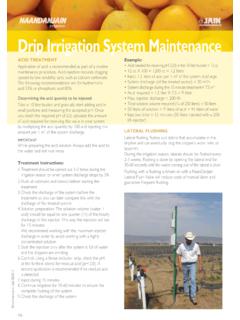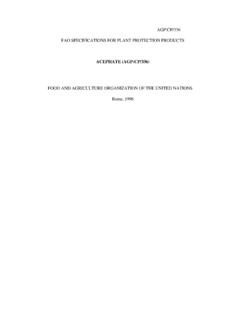Transcription of SUGAR CANE - NaanDan Jain Irrigation Ltd
1 SUGAR cane . BACKGROUND. The SUGAR cane is a perennial tropical grass with shallow fibrous root system . Plant (first) crop is normally followed by 2 to 4 ratoon crops, and in certain cases up to a maximum of 7 crops are taken (in Lain America). A ratoon is the cane that grows from buds remaining in the stubble left in the ground after a crop has been harvested. It's grown for the SUGAR mainly but today ethyl alcohol (Biofuel) production is widely spreading, molasses and fiber (bagasse) are by products. SUGAR cane can be grouped into three varieties: early, mid- late and late. It is propagated vegetativly by planting stem cutting (setts).
2 From which axillary buds grow to produce stalks (main stem). Secondary and tertiary stalks (tillers) are produced at the base of the primary stalk. SUGAR cane Irrigation is by furrow, sprinklers and drip methods. The drip system already started at the 70th of the 20 century, in Hawaii and today its spread in all the growing areas, contribute to higher yields and with improved efficiency. Good yield are in the range of 100-160 ton ha while in India maximal commercial results reaching already 250-300 ton/ha by introduction of the new management concept by Jain. SUGAR cane is grown in more than a hundred countries under temperate, subtropical and tropical conditions.
3 Top ten sugercane producers Country Production (tons). Brazil 672,157,000. India 285,029,000. China 116,251,272. NAANDANJAIN Ltd. 05/2013. Thailand 66,816,400. Pakistan 50,045,400. Mexico 49,492,700. Colombia 38,500,000. Philippines 32,500,000. Australia 30,284,000. Argentina 29,000,000. CLIMATE. The yields affected significantly by temperature, relative humidity and solar radiation. Optimum temperature for sprouting (germination) of stem cuttings is 32 to 38 C. Optimum growth is achieved with mean daily temperatures between 22 and 30 C. Minimum temperature for active growth is approximately 20 C.
4 For ripening, however, relatively lower temperatures in the range of 20 to 10 C are desirable, since this has a noticeable influence on the reduction of vegetative growth rate and the enrichment of sucrose in the cane . A long growing season is essential for high yields. The normal length of the total growing period varies between 9 months with harvest before winter frost to 24. months in Hawaii, but it is generally 15 to 16 months. The flowering of sugarcane is controlled by day length, but it is also influenced by water and nitrogen supply. Flowering has a progressive deleterious effect on sucrose content.
5 Normally, therefore, flowering is prevented or non- flowering varieties are used. Stalk growth increases when daylight is in the range of 10 14 hours. GROWTH STAGES. There are four growth stages: Germination and emergence Tillering and canopy establishment Grand growth ( 120-270 days after planting). Ripening Each stage will have specific water and fertilizers requirements Gerimation &establishment Tillering phase Stem elongation Grand growth period Ripening phase phase SOIL 10-30 days 150-350 days 70-200 days 50-70 days SUGAR cane requires a well-drained, aerated soil. after Kuyper, 1952.
6 Compacted soils affect root penetration, water and nutrient soil pH range between with optimal of Sugarcane is moderately sensitive to salinity . NAANDANJAIN Ltd. 05/2013. Decrease in crop yield due to increasing salinity is: Salinity levels (mmhos/cm) Crop decrease (%). Up to 0. 10. 25. PLANTING PATTERN. The planting pattern is single row or double row according to local practice, soil, climate and variety. With mechanical harvesting a single row pattern is common. Planting depth is generally 10-15cm. The crop is grown by vegetative propagation and requires 40,000 two-bud or 30,000 three-bud setts per hectare in order to maintain desired millable tillers.
7 Stalk population target of 130,000 ha for high yields. Recent results of Jain in India achieve higher yields with planting of 62,000 ,two- bud, at 165cm row spacing, results with 150,000 tillers and 250 ton /ha Double (paired) row Two common spacing are120-150cm (pairs center to center) x 45cm in between the pair and 200x 70 cm, (other combination are exist ). The pair to pair spacing depends on soil fertility; higher the fertility wider the spacing. Other consideration is the cost of the drip system. Single row spacing Double (paired) row 90 to 150 cm between rows WATER General curve of crop water requirement For high yields, the seasonal crop water requirements are in the range of 1100.
8 NAANDANJAIN Ltd. 05/2013. to 1500 mm according to climatic conditions and varying lengths of growing seasons (12 14 months), with a daily evapotranspiration rate of 4 to 7 mm/day. The crop coefficient (kc) values, for different growth of stages Development stages Days Kc coefficient*. Planting to full canopy 30-60 to full canopy 30-40 to full canopy 15-25 to full canopy 45-55 Peak use 180-330 Early senescence 30-150 Ripening 30-60 * Source FAO publication To calculate the daily water requirement multiple the daily ET by the relevant Kc. Tensiometers guide line The Tensiometer (moisture sensor in the soil) can assist in the decision when to irrigate and can control accesses of watering.
9 Installation depth: 20cm Moisture tension trigger for Irrigation : 15 25 centibars at tillering and grand growth 60 centibars at ripening period FERTILIZATION. SUGAR cane is a heavy consumer of nutrients. Its root system is shallow and fibrous, therefore, fertigation is recommended for higher nutrient availability and use efficiency. The aim of the fertigation program is to supply the nutrients required by the SUGAR cane on time and to minimize losses due to leached nitrate. Fertilizers program It is always preferable to take soil analysis, before the season, to preform optimal fertilizers program.
10 If it's not available, use the recommended table (For ratoon crops increased quantities by 25% to maintain higher yields). NAANDANJAIN Ltd. 05/2013. Nitrogen Phosphorus Potassium (N) (P2O5) (K20). 250 300 kg/ha 80 100 kg/ha 125 250 kg/ha Basal application N will be about 80 kg/ha at the time of land preparation before planting. Farm manure in the rate of ton/ha is recommended Fertilizers (kg/ha) Vs. growth stage Nitrogen Phosphorus Potassium Growth period (N) (P2O5) (K20). Emergence and establishment 30 25. Tillering Formative phase I 40 35 50. Formative phase II 100 25 10. Grand growth I 80 15 20.





